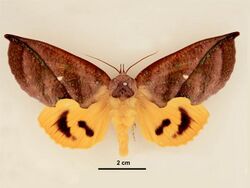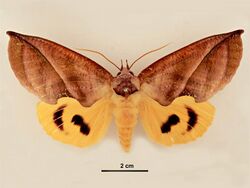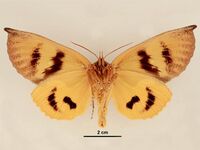Biology:Eudocima aurantia
| Fruit-sucking moth | |
|---|---|

| |
| Female, dorsal view | |

| |
| Male, dorsal view | |
| Scientific classification | |
| Domain: | Eukaryota |
| Kingdom: | Animalia |
| Phylum: | Arthropoda |
| Class: | Insecta |
| Order: | Lepidoptera |
| Superfamily: | Noctuoidea |
| Family: | Erebidae |
| Genus: | Eudocima |
| Species: | E. aurantia
|
| Binomial name | |
| Eudocima aurantia (Moore, 1877)
| |
| Synonyms | |
| |
Eudocima aurantia, the fruit-sucking moth,[1] is a moth of the family Erebidae. The species was first described by Frederic Moore in 1877. It is found across south-east Asia, from Sri-Lanka to northern Queensland, Australia . It is also present on the Andamans.
Description
The wingspan is about 90–120 mm. Palpi with third joint long and spatulate at extremity. Forewings with produced apex to a rounded lobe. Head and thorax ferrous colored, with plum-color suffusion. Abdomen orange. Forewing ferrous with dark stria and slight purple bloom. The veins speckled with blue. Reniform green and indistinct. There is a dark line runs from apex to center of inner margin, sometimes with green patches beyond it. Hindwings orange with a large black lunule beyond lower angle of cell. A submarginal patch can be seen between veins 1 and 2. Ventral side orange. Forewings with black mark below angle of cell and beyond the cell between veins 3 and 5. Hindwings with lunule and patch of upperside.[2]
Ecology
Larva has pinkish grey dorsal surface suffused darker to a V-shaped yellow band. It has black spiracles and marbled white-ringed rufous-orange ocellate marks with three ferrous lines crossing them. The larvae feed on Cocculus species. The adults are a pest on various fruits. They pierce the fruit in order to suck the juice.[3]
Adults and caterpillars both harm fruits, by piercing, sucking juice and eating flesh. Fruits may show pre-mature fall due to the attack. Parasitoids such as Telenomus lucullus and Euplectrus melanocephalus used as controlling measures.[4]
References
- ↑ "Species: Eudocima aurantia". http://bie.ala.org.au/species/urn:lsid:biodiversity.org.au:afd.taxon:2c8cb215-5d63-42d2-b59f-62638ff69d38.
- ↑ Hampson, G. F. (1894). The Fauna of British India, Including Ceylon and Burma: Moths Volume II. Taylor and Francis. https://www.biodiversitylibrary.org/item/180400#page/5/mode/1up.
- ↑ Holloway, Jeremy Daniel. "Eudocima [Khadira aurantia Moore"]. http://www.mothsofborneo.com/part-15-16/calpini/calpini_4_6.php. Retrieved 18 August 2016.
- ↑ Herbison-Evans, Don; Crossley, Stella (23 February 2017). "Eudocima aurantia (Moore, 1877) Fruit Sucking Moth". http://lepidoptera.butterflyhouse.com.au/calp/aurantia.html. Retrieved 15 January 2019.
External links
Wikidata ☰ Q5406556 entry
 |



